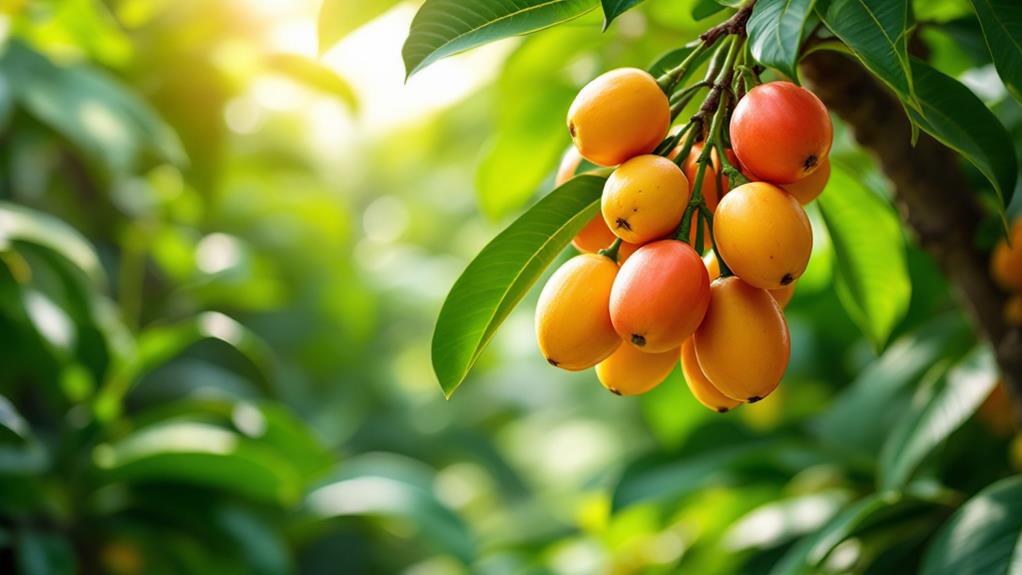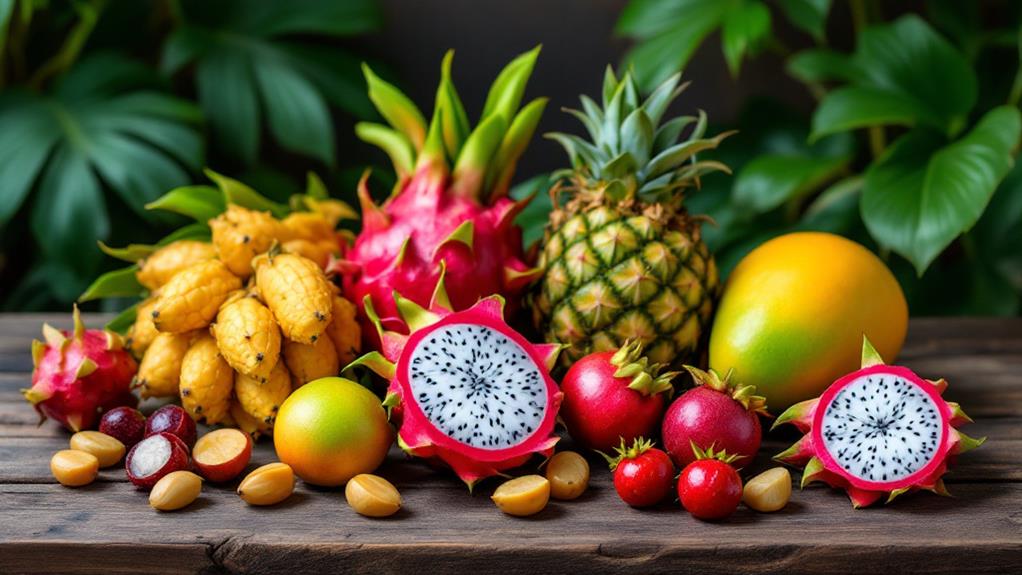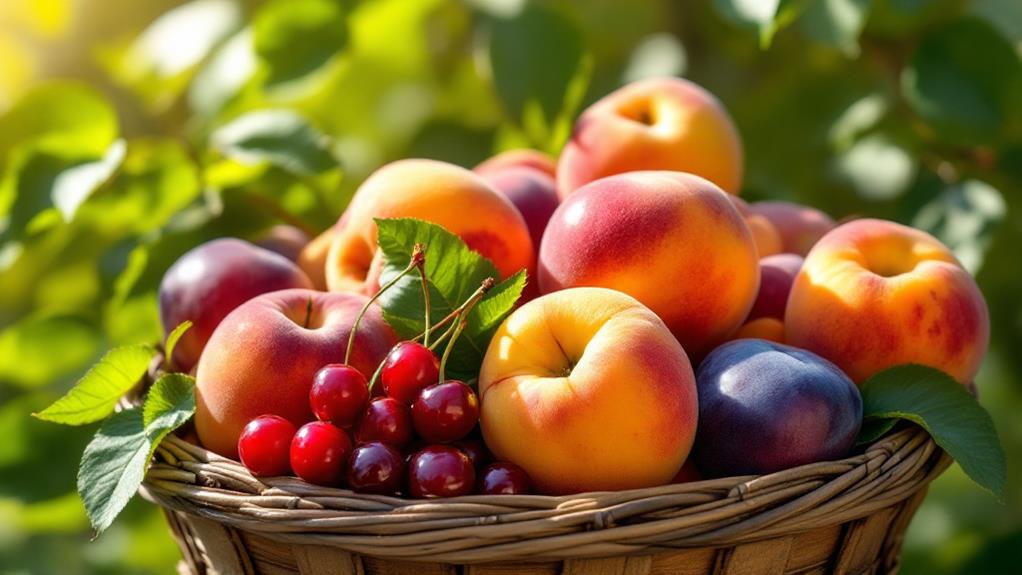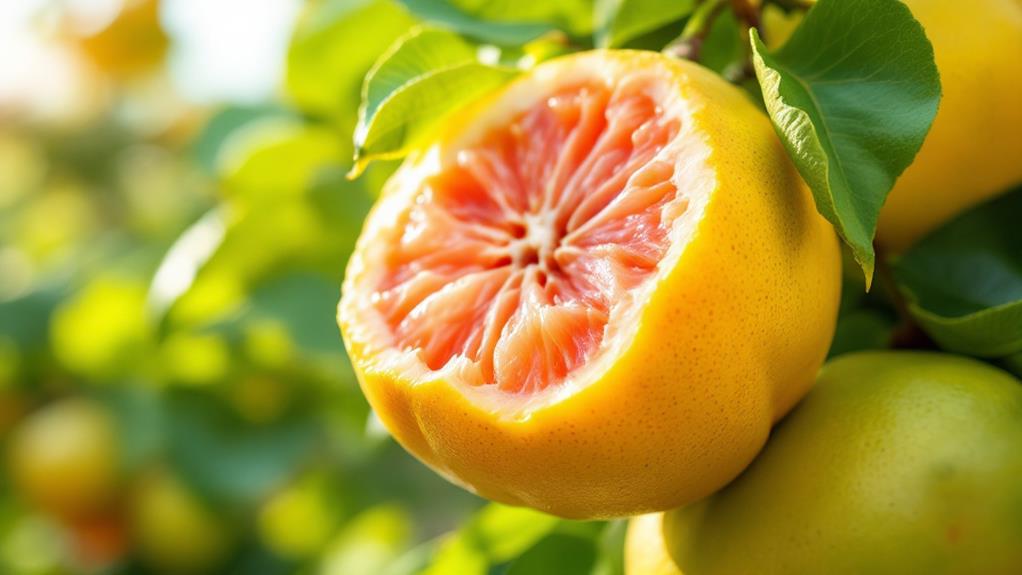Everything You Need to Know About the Sapodilla Tree
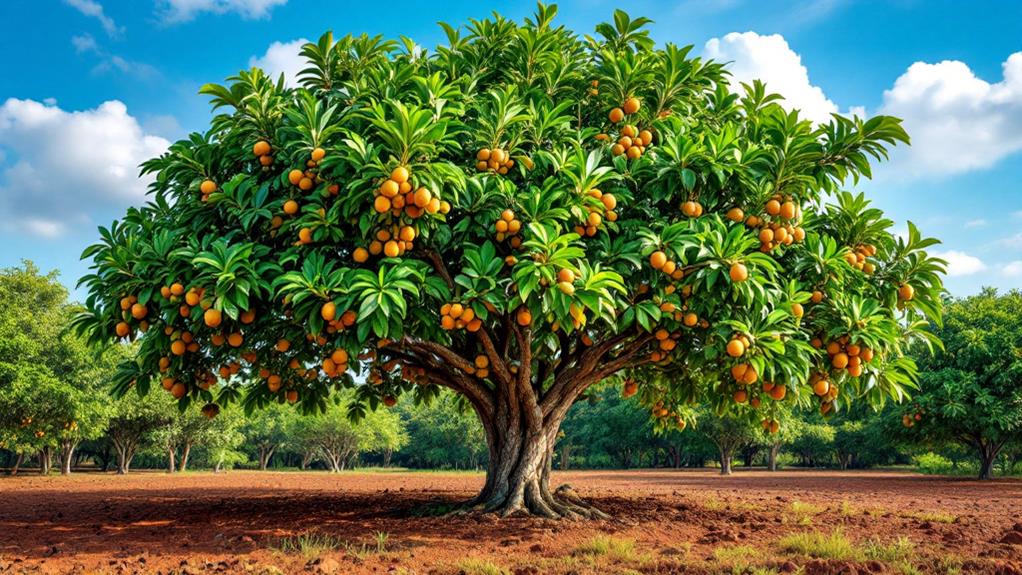
The sapodilla tree is a intriguing tropical plant reaching up to 50 feet tall, renowned for its sweet, rusty-brown fruits. Its durable wood has historical significance, once used by the Mayans, while also playing a key role in modern natural products through chicle, an early form of chewing gum. Sapodillas thrive in warm climates like USDA zones 9-11, requiring full sun and well-drained soil. Easy to grow, they need minimal pruning and are resilient against pests if properly cared for. Packed with vitamins and fiber, they're not just delicious but nutritious. There's much more to investigate about this fascinating tree.
Botanical Characteristics
Exploring the botanical characteristics of the sapodilla tree reveals its intriguing nature. As a medium-sized tree, the sapodilla, scientifically known as Manilkara zapota, reaches heights of 30 to 50 feet with a width spanning 20 to 30 feet. It's a slow-growing member of the Sapotaceae family, known for its tropical evergreen trees. The tree's glossy leaves, which are light green and ovate to elliptic, measure between 5 to 12.5 cm in length. These leaves not only provide a lush appearance but also contribute to the tree's overall visual appeal.
The sapodilla tree produces unique fruits that are spheroid to ovoid in shape. These fruits, with their rusty brown surface, range from 5 to 10 cm in diameter. Inside, you'll find 2 to 5 shiny black seeds situated within the sweet, edible flesh. The fruits are a distinctive feature of the sapodilla tree, contributing to its allure in both natural and cultivated settings.
Additionally, the tree's reddish, hard, and durable wood has historical significance, having been used in ancient Mayan structures. Its durability is one of the reasons this tree remains valued beyond its fruits and foliage.
Historical and Cultural Significance
In the rich tapestry of Mesoamerican history, the sapodilla tree stands out for its multifaceted significance. This tree, scientifically known as Manilkara zapota, played a crucial role for both the Aztecs and Maya. They harvested its latex, known as chicle, to create the initial natural chewing gum. But chicle's use didn't stop there; the ancient Maya also used it as a dental filling, which underscores the sapodilla's cultural importance and practical applications in daily life.
The sapodilla's influence extended beyond its latex. Elaborately carved sapodilla wood artifacts found in Mayan ruins highlight the tree's value and its integral role in Mesoamerican culture. This wood was not just functional but also a medium for artistic expression.
Moreover, chewing sapodilla was more than just a pastime; it was a communal activity symbolizing hospitality and connection among indigenous communities. This tree's impact is still evident today in local cuisines and medicinal practices.
- Chicle from sapodilla was the initial natural chewing gum.
- Sapodilla wood artifacts showcase artistic and cultural significance.
- Chewing sapodilla fostered community and connection.
The sapodilla tree continues to be cherished for its rich historical and cultural significance.
Varieties and Description

From its historical roots in Mesoamerican culture, the sapodilla tree continues to thrive with a variety of forms and characteristics. These large trees, scientifically called Manilkara zapota, can grow to impressive heights of 30-50 feet. Their canopy ranges from pyramidal to rounded shapes, offering a dense, evergreen cover. The leaves are a striking feature, starting off with a pinkish hue and maturing into a dark green, clustering beautifully at the shoot ends. You'll find the small, off-white, bell-shaped flowers add to the tree's ornamental charm.
Sapodilla trees are loved not just for their majestic presence, but also for their delectable fruit. The tropical fruit they produce is spheroid to ovoid, with a rusty brown exterior and a size of 2-4 inches in diameter. Inside, you'll uncover a sweet pulp with a sugar content of 19-24°Brix, making it a delightful treat. Recent efforts in places like Florida and Mexico have led to the development of new cultivars. These focus on high-yield production and a smooth, sweet pulp. It's best not to propagate sapodilla trees from seeds, as it often leads to unpredictable results. Instead, stick to these refined cultivars for consistency.
Ideal Climate Conditions
A sapodilla tree truly flourishes in tropical and warm subtropical climates, where full sun exposure is vital for its ideal growth. If you're thinking about growing sapodilla in Florida, you're in luck because the state's climate matches the tree's needs perfectly. The sapodilla tree is best suited for USDA growing zones 9-11, making outdoor cultivation viable in these areas. When planting your tree, make sure the location receives full sun to optimize its growth potential.
Keep in mind that sapodillas prefer well-drained soil. This helps prevent waterlogging, which can negatively impact the tree's growth and fruit production. Avoid areas prone to prolonged flooding for the best results. Here are some key considerations:
- Temperature Tolerance: The sapodilla tree can handle temperatures down to 26°F briefly, but young saplings are at risk below 30°F.
- Soil Preferences: Well-drained soil is necessary to avoid waterlogged conditions that could stunt growth.
- Flexibility: The tree adapts to both arid and humid environments.
Planting Techniques
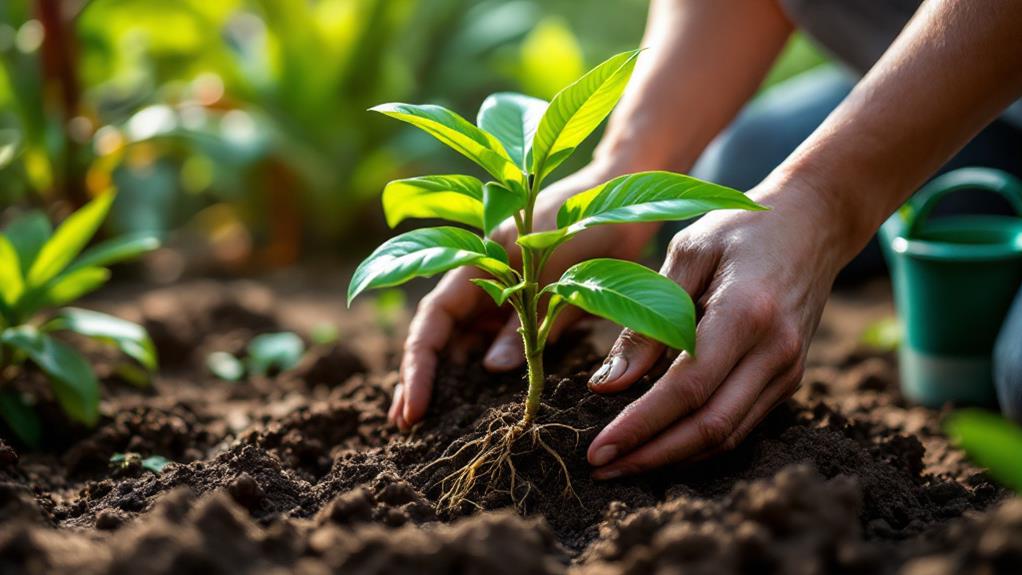
In relation to planting sapodilla trees, some might say preparation is key. To give your young sapodilla the best start, you'll want to dig a hole that's 3-4 times the diameter and 3 times deeper than the container. This guarantees ample space for the roots to expand and grow strong. It's essential to resist the urge to add fertilizer directly into the planting hole; instead, use the native soil to backfill the hole and water the tree right after planting.
If you're dealing with sandy soil, improve it by incorporating well-rotted manure or compost into the planting hole. This will increase the soil quality and provide much-needed nutrients for young sapodilla development. After planting, apply a 2-3 inch layer of organic mulch around the root zone. This helps retain moisture and reduces competition from weeds, giving your tree a better chance to thrive.
In the early stages, keep a close eye on watering needs. Sapodillas, especially young ones, require watering every other day for the initial week. With these planting techniques, you'll pave the way for your sapodilla to grow into one of those majestic mature trees.
Care and Maintenance
Guaranteeing your sapodilla tree thrives involves understanding its specific care and maintenance needs. Start by positioning your trees in a location with full sun exposure, making certain they get at least six hours of direct sunlight daily. This helps them develop the light green foliage and increases fruit production. Water newly planted sapodilla trees every other day for the initial week. Once established, about an inch of water per week should suffice. Consistent watering keeps the trees well-hydrated and healthy.
Fertilization is vital for these fruit trees. Apply a tropical fruit tree fertilizer in the spring before new growth appears. Look for a composition with 8% nitrogen, 2-4% phosphoric acid, and 6-8% potash to promote robust growth and abundant fruiting.
- Guarantee at least six hours of sunlight for ideal growth.
- Apply tropical fruit tree fertilizer in spring.
- Water newly planted trees every other day at the outset.
Minimal pruning is needed, but check regularly for broken or diseased branches to maintain tree health. Planting multiple sapodilla trees together improves growth and fruit production through cross-pollination, even though they are self-fertile. This approach optimizes your harvest potential.
Pest and Disease Management
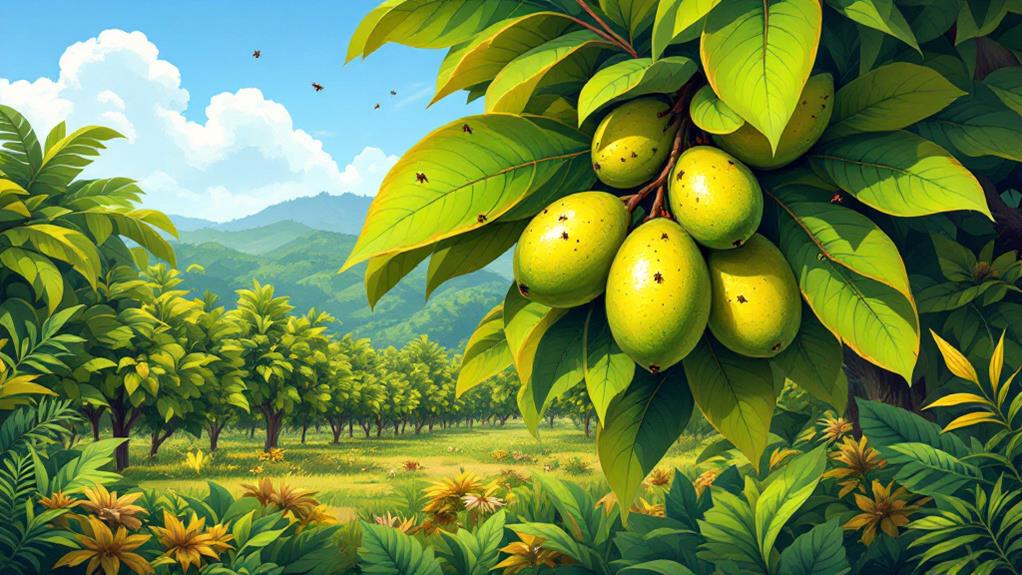
Protecting your sapodilla trees from pests and diseases is vital for maintaining their health and maximizing fruit yield. Effective pest and disease management starts with knowing the common issues affecting sapodillas. Caribbean fruit flies are notorious pests that can greatly impact fruit quality. Regular monitoring is fundamental to catch infestations early. If you spot these pests, consider consulting your local extension office for control recommendations.
Leaf rust is a minor disease that might show up on your sapodilla leaves. While it's generally not severe, maintaining control is significant to prevent any potential spread. An organic copper fungicide can be applied to manage this problem effectively. Keep an eye out for symptoms and apply the fungicide as needed.
Maintaining a grass-free zone around your tree's trunk is another significant step. This practice helps prevent injury from lawn equipment and reduces pest and disease risks. Controlling weeds through herbicides, hand weeding, or mulching helps minimize competition for nutrients and water.
Harvesting and Uses
After safeguarding your sapodilla trees from pests and diseases, it's time to focus on the rewarding process of harvesting and utilizing the fruit. Sapodilla fruit usually ripens 4 to 10 months after flower drop. If you're growing in Florida, the peak harvest season is typically from May to September. You'll know you have ripe fruit when the skin turns smooth and changes color, signaling it's ready for consumption.
When harvesting, handle the fruit gently to avoid bruising. Sapodilla is best enjoyed fresh due to its natural sweetness, but its adaptability allows it to shine in different culinary applications. You can incorporate sapodilla fruit into desserts like sherbets and ice cream, making the most of its sweet flavor and nutritional benefits.
- Fresh consumption: Enjoy it straight from the tree.
- Desserts: Use in sherbets and ice cream.
- Traditional remedies: Thanks to its high fiber and antioxidant properties.
Rich in vitamin C, sapodilla fruit not only satisfies your sweet tooth but also contributes to a nutritious diet. Its high levels of fructose and sucrose make it calorie-rich, while the presence of vitamins A, potassium, and copper improves its nutritional profile.
Nutritional Value and Health Benefits
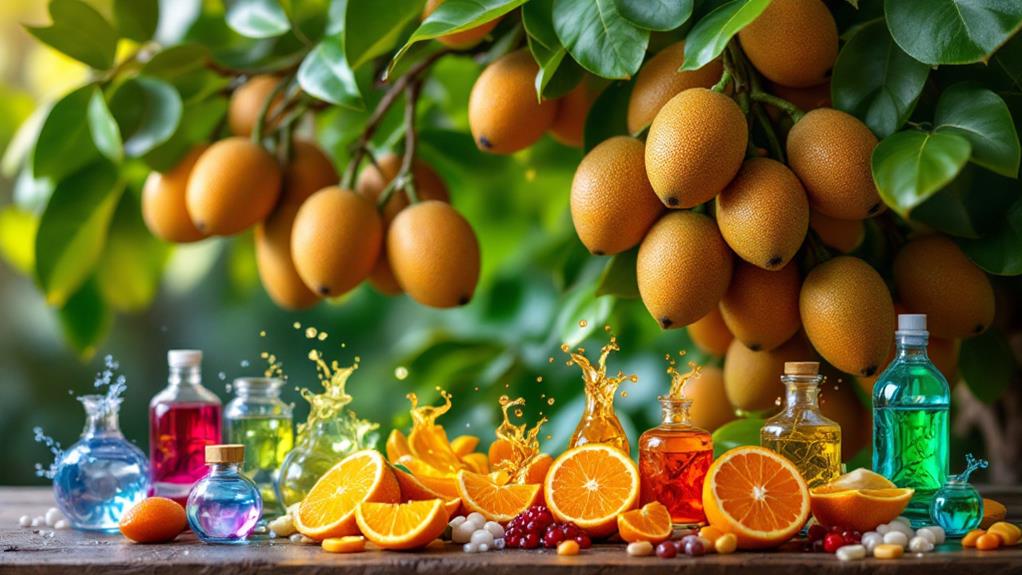
When you savor a sapodilla, you're not just enjoying its sweetness but also reaping numerous nutritional benefits. This delectable fruit is packed with vital vitamins like vitamin C and A, which play an important role in enhancing your immune system and maintaining general health. Vitamin C, in particular, is a powerful antioxidant that helps protect your body from harmful free radicals.
Sapodilla's nutritional value extends beyond vitamins. It's a rich source of dietary fiber, aiding digestion and promoting regular bowel movements. This fiber content supports gut health and can help prevent constipation. You'll also benefit from the fruit's high levels of fructose and sucrose, providing a quick energy lift when you need it.
Moreover, sapodilla's antioxidant properties, derived from tannins, may help reduce inflammation and offer protection against infections. These properties highlight its potential therapeutic role, aligning with traditional uses for treating gastrointestinal issues in folk medicine. By incorporating sapodilla into your diet, you're not only enjoying a sweet treat but also harnessing its health benefits. This fruit's unique combination of nutrients and antioxidants makes it a valuable enhancement to a balanced and health-conscious lifestyle.
Modern Applications and Alternatives
In the current market, chicle from the sapodilla tree is carving out a niche as a sought-after ingredient in natural and organic products. As consumers increasingly prioritize sustainability, chicle stands out due to its eco-friendly and sustainable properties. Brands like Gud Gum and Glee Gum capitalize on chicle's natural origins, setting themselves apart from synthetic gum alternatives. This shift towards chicle not only satisfies consumer demand but also supports biodiversity and sustainable agricultural practices.
Here's why chicle is gaining traction:
- Natural Ingredient: Unlike synthetic gums, chicle is derived directly from nature, aligning with the eco-conscious consumer's values.
- Promotes Biodiversity: By choosing chicle, you're supporting ecosystems that rely on the sapodilla tree, fostering biodiversity.
- Sustainable Practices: Harvesting chicle encourages sustainable farming methods, benefiting both the environment and local communities.
Research into chicle's health benefits is ongoing, with promising insights into its potential digestive advantages over synthetic gums. This natural product doesn't just serve as a gum base; it represents a shift towards more sustainable living, emphasizing the importance of biodiversity and eco-friendly choices. By opting for chicle, you contribute to a healthier planet and a sustainable future.

